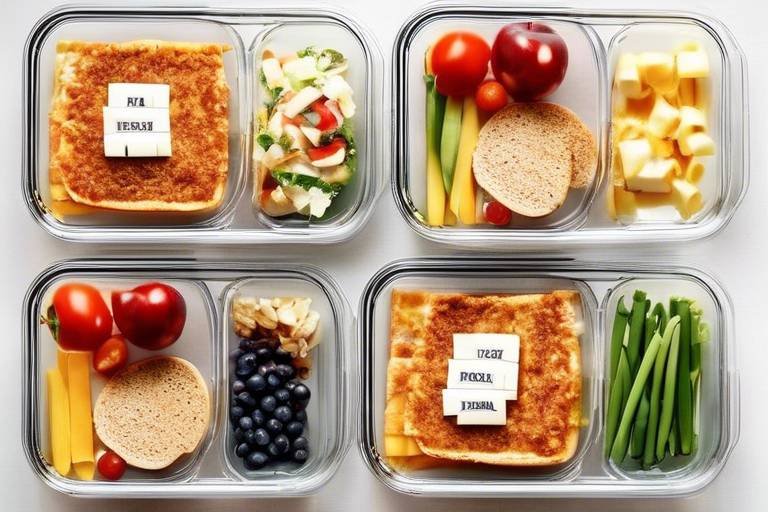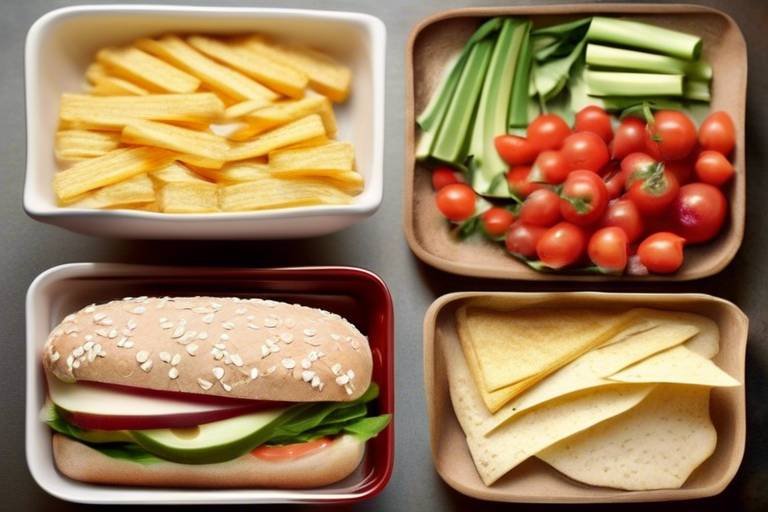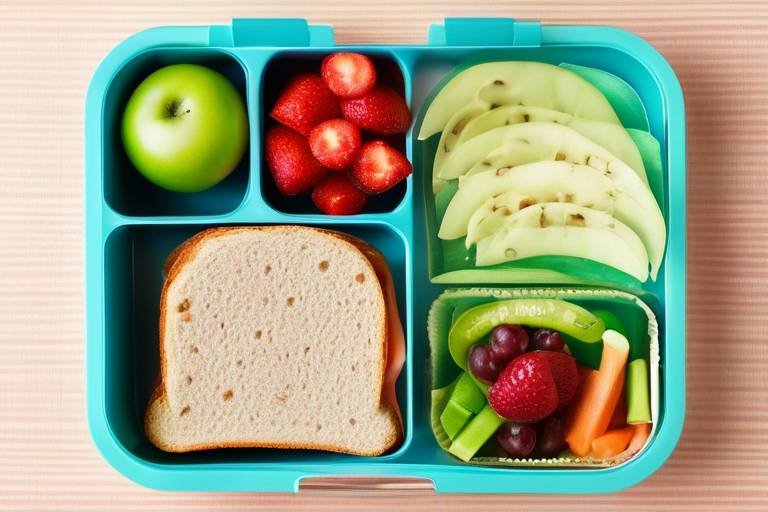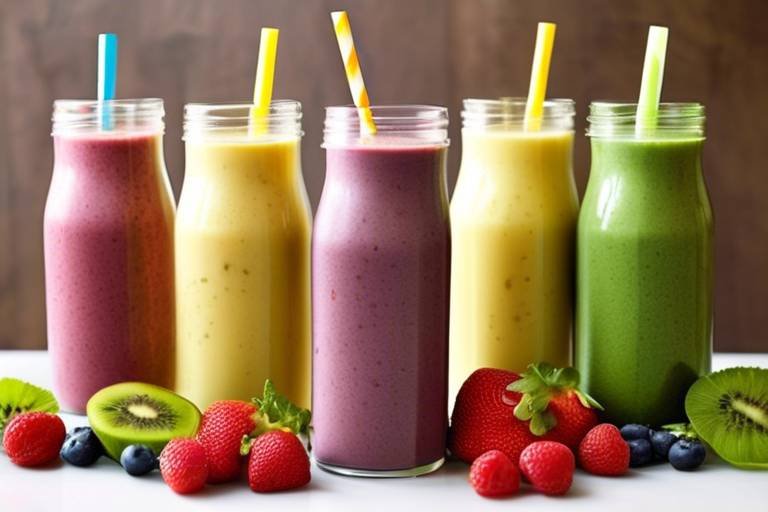Easy and Affordable Meal Plans for College Students
As a college student, you’re probably juggling classes, assignments, and maybe even a part-time job. With all that on your plate, the last thing you want is to spend hours figuring out what to eat. But don’t worry! This article is here to guide you through practical meal planning ideas that are not only budget-friendly but also simple to prepare. Eating healthy doesn't have to mean spending a fortune; in fact, with a bit of planning, you can enjoy a variety of delicious meals without breaking the bank.
Meal planning is like having a roadmap for your week. It helps you navigate through the chaos of college life while ensuring you get the nutrients you need to stay energized and focused. Think of it as your secret weapon against the dreaded “what’s for dinner?” dilemma. By taking a little time to plan, you can save money, reduce stress, and even impress your friends with your culinary skills!
But what exactly does meal planning entail? It starts with understanding your body’s nutritional needs. You need a balanced intake of proteins, carbohydrates, fats, vitamins, and minerals to fuel those late-night study sessions and early morning classes. The good news is that you can meet these needs affordably. Let’s dive into some essential strategies that will help you create easy and affordable meal plans tailored just for you!
Many college students often overlook their nutritional requirements, opting for quick snacks and fast food instead. However, it's crucial to understand that your body needs a variety of nutrients to function optimally. A well-rounded diet can enhance your concentration, boost your energy levels, and even improve your mood. So, what are the essential nutrients you should focus on?
- Proteins: Essential for muscle repair and growth. Look for affordable sources like beans, lentils, eggs, and chicken.
- Carbohydrates: Your main energy source. Choose whole grains, fruits, and vegetables for sustained energy.
- Fats: Necessary for brain health. Incorporate healthy fats from avocados, nuts, and olive oil.
- Vitamins and Minerals: Crucial for various bodily functions. Aim for a colorful plate with plenty of fruits and veggies.
By planning your meals around these key nutrients, you can ensure that you’re not just filling your stomach but also nourishing your body. Just imagine how much better you’ll feel when you’re fueling yourself with the right foods!
Now that you understand your nutritional needs, let's tackle the elephant in the room: budgeting. Creating a budget for meals is essential for college students who want to eat well without overspending. Start by determining how much you can realistically allocate for food each month. This figure will guide your shopping and meal planning.
Consider these tips to make the most of your food budget:
- Track your spending for a month to see where your money goes.
- Prioritize buying staple ingredients that can be used in multiple meals.
- Don’t shy away from frozen fruits and vegetables—they’re often cheaper and just as nutritious!
With a little creativity and planning, you can enjoy a variety of meals without feeling the pinch in your wallet. Now, let’s move on to some smart grocery shopping tips!
Grocery shopping doesn’t have to be a daunting task. In fact, it can be quite enjoyable if you approach it with the right mindset. Start by making a shopping list based on your meal plan. This will not only keep you focused but also help you avoid impulse buys that can derail your budget.
When you’re at the store, compare prices between brands and consider choosing store brands, which are often just as good as name brands but at a lower cost. And remember, if you can buy in bulk, do it! This strategy can save you money in the long run and ensure you always have essential ingredients on hand.
Coupons are your best friend when it comes to saving money on groceries. Take some time to look for digital coupons or weekly ads from your local grocery stores. You’d be surprised at how much you can save with just a little effort!
Buying staple items in bulk can significantly reduce costs over time. Items like rice, pasta, and canned goods have a long shelf life and can be the backbone of many meals. Plus, having these essentials on hand means you can whip up a meal in no time!
Meal prepping is a game-changer for busy college students. By preparing meals in advance, you can save time during the week and avoid the temptation of ordering takeout. Start by dedicating a few hours on the weekend to cook and portion out your meals for the week. Use containers to keep everything organized and easily accessible.
Now that you have your meal plan and budget sorted, let’s get to the fun part—cooking! Here are a few quick and easy recipes that require minimal ingredients and time, perfect for busy college students:
One-pot meals are a lifesaver! They’re not only convenient but also reduce cleanup time. Think of a hearty chili or a flavorful stir-fry. You can throw in whatever veggies and proteins you have on hand, making it a versatile option.
Freezer-friendly meals can be a lifesaver for busy students. Consider making a big batch of soup or pasta and freezing portions for later use. This way, you always have a meal ready to go, even on the busiest of nights!
Q: How can I make meal prep easier?
A: Start with simple recipes and gradually build your skills. Use a slow cooker or instant pot for convenience!
Q: What are some affordable protein options?
A: Eggs, beans, lentils, and canned tuna are all budget-friendly sources of protein.
Q: Can I meal prep for one person?
A: Absolutely! Just adjust the portion sizes to fit your needs and freeze leftovers for later.
By following these tips and strategies, you’ll be well on your way to enjoying easy, affordable, and nutritious meals throughout your college journey. Happy cooking!

Understanding Nutritional Needs
When it comes to college life, many students find themselves juggling classes, social activities, and part-time jobs, often leaving little time to focus on what really matters: nutrition. It's easy to overlook the essential nutrients your body craves when you're living off instant noodles and late-night pizza, but understanding your nutritional needs is crucial for maintaining energy, focus, and overall health. So, what exactly does your body need to thrive during these hectic years?
Let's break it down. Your body requires a balance of macronutrients and micronutrients to function optimally. Macronutrients include carbohydrates, proteins, and fats, while micronutrients consist of vitamins and minerals. Each plays a unique role in your health:
- Carbohydrates: These are your body's primary source of energy. Think of them as the fuel that keeps your engine running. Whole grains, fruits, and vegetables are excellent sources.
- Proteins: Essential for muscle repair and growth, proteins are the building blocks of your body. Incorporate lean meats, beans, and legumes into your meals to meet your protein needs.
- Fats: Don't shy away from healthy fats! They support cell growth and hormone production. Avocados, nuts, and olive oil are great options.
Now, let's not forget about those vital micronutrients. Vitamins and minerals like Vitamin C, iron, and calcium are crucial for various bodily functions, including immune support and bone health. A colorful plate is often a good indicator that you're getting a variety of these nutrients. Aim for a mix of different fruits and vegetables, as each color typically represents different vitamins and minerals.
Meal planning can help you meet these nutritional needs effectively. By preparing meals in advance, you can ensure that you're not just grabbing whatever is convenient, but rather choosing foods that nourish your body. This approach not only saves time but also encourages you to make healthier choices. Think of meal planning as your personal roadmap to a balanced diet, guiding you through the chaos of college life.
In summary, understanding your nutritional needs is the first step toward a healthy lifestyle in college. By focusing on a balanced intake of macronutrients and micronutrients, you can fuel your body for success. Remember, you are what you eat, so make those choices count!

Budgeting for Meals
When it comes to college life, budgeting is a skill that can make or break your experience. With tuition fees, textbooks, and social activities, it’s easy to overlook the importance of a well-planned food budget. But here’s the kicker: eating healthy doesn’t have to be expensive! By understanding how to allocate your monthly food budget, you can enjoy a variety of delicious meals without feeling the pinch on your wallet. So, how do you get started?
First things first, it’s essential to know how much you can realistically spend on food each month. Take a moment to look at your income sources—whether it’s from a part-time job, allowance from parents, or financial aid. Once you have a clear picture of your finances, you can set a monthly food budget. A good rule of thumb is to allocate around 10-15% of your total budget for groceries. This percentage can vary based on your lifestyle and dietary preferences, but it’s a solid starting point.
Next, consider keeping track of your spending. This might sound tedious, but it’s incredibly helpful. You can use apps or even a simple spreadsheet to log your weekly grocery expenses. By doing this, you’ll quickly see where your money is going and identify areas where you can cut back. For instance, if you notice you’re spending too much on snacks, you might want to rethink your choices. Remember, every dollar saved can go towards something more fun, like a night out with friends!
Now, let’s talk about meal variety. Just because you’re on a budget doesn’t mean you have to eat the same boring meals every day. In fact, budgeting for meals can actually encourage you to try new recipes and ingredients. Here’s a tip: plan your meals for the week ahead. This not only helps you stay organized but also allows you to make the most of sales and discounts at your local grocery store. By planning, you can create a shopping list that includes all the ingredients you need, which helps avoid impulse buys that can derail your budget.
To give you a clearer picture, let’s break down a sample monthly food budget:
| Category | Estimated Cost |
|---|---|
| Groceries | $200 |
| Dining Out | $100 |
| Snacks & Drinks | $50 |
| Total | $350 |
This sample budget allocates a total of $350 for the month, which can be adjusted based on your personal preferences and needs. The key takeaway here is to find a balance that works for you. If you tend to eat out more often, try to limit those expenses by cooking at home more frequently. You’d be surprised at how much money you can save by whipping up your meals!
Lastly, don’t forget about the power of community. Consider teaming up with roommates or friends for bulk buying. Purchasing items like rice, pasta, or canned goods in larger quantities can be more economical and ensure you always have essentials on hand. Plus, cooking together can be a fun way to bond and share recipes!
In summary, effective meal budgeting isn’t just about pinching pennies; it’s about making informed choices that contribute to your overall well-being. By keeping track of your spending, planning your meals, and exploring new ways to save, you can enjoy a variety of nutritious meals without breaking the bank. Remember, a little planning goes a long way in ensuring you eat well while enjoying your college experience!

Smart Grocery Shopping
When it comes to grocery shopping, being a savvy shopper can make all the difference for college students trying to stick to a budget. Imagine walking into a grocery store like a seasoned warrior, ready to conquer your grocery list without emptying your wallet. The first step is to always create a shopping list before you head out. This simple act can save you from impulse buys that can wreak havoc on your budget. Think of your shopping list as your battle plan; it keeps you focused and helps you avoid those shiny distractions that can lead you astray.
Next, always compare prices. This might sound tedious, but it’s crucial. Different stores often have varying prices for the same items. Take a moment to check the unit prices, which can help you determine the best deal. For instance, if you see two brands of pasta, one priced at $1.50 for a 16 oz package and another at $2.00 for a 24 oz package, the second option is a better deal even though it seems more expensive at first glance. It’s like finding hidden treasure in your grocery store!
Another tip is to consider store brands. Many grocery chains offer their own brands that are often just as good as name brands but significantly cheaper. Think of it as a secret weapon in your grocery shopping arsenal. You might be surprised at how much you can save by opting for these alternatives. Plus, you can use those savings to treat yourself to a nice coffee or a night out with friends!
Let’s not forget about the importance of seasonal shopping. Buying fruits and vegetables that are in season can save you a lot of money. Seasonal produce is often fresher and cheaper. For example, if you’re shopping in the summer, look for berries, tomatoes, and cucumbers, which are typically abundant and inexpensive. It’s like having nature’s bounty at your fingertips, and it can make your meals both delicious and affordable!
Lastly, consider utilizing apps and websites that help you find deals and discounts. Many grocery stores have their own apps where you can view weekly ads, digital coupons, and even loyalty rewards. By taking advantage of these tools, you can maximize your savings and make your grocery shopping experience much more efficient. You could even set aside a few minutes each week to browse these deals, making it a fun little ritual before you hit the store!
In summary, smart grocery shopping is all about preparation and awareness. By creating a shopping list, comparing prices, opting for store brands, buying seasonal produce, and utilizing technology, you can stretch your grocery budget further than you might think. So grab your list and your reusable bags, and get ready to shop like a pro!
- How can I save money while grocery shopping? Start by creating a shopping list, comparing prices, and opting for store brands.
- Is it worth buying in bulk? Yes, buying in bulk can save you money in the long run, especially for non-perishable items.
- What are some budget-friendly meal ideas? Look for one-pot meals or freezer-friendly recipes that utilize affordable ingredients.
- How can I make meal prep easier? Set aside a specific time each week for meal prep to ensure you have healthy meals ready to go.

Using Coupons and Discounts
In today's world, where every penny counts, using coupons and discounts can be a game-changer for college students trying to stretch their budgets. Think of coupons as little golden tickets that can unlock significant savings on your grocery bills. But how do you make the most of them? It’s easier than you might think!
First off, start by making it a habit to check for coupons before heading out to the store. Many grocery stores offer weekly ads that feature discounts on popular items. You can find these ads in your mailbox, online, or even in-store. Take a moment to browse through these ads and look for items you regularly purchase. It’s like finding treasure in your own backyard!
Additionally, there are numerous apps and websites dedicated to helping you find the best deals. Some popular ones include:
- RetailMeNot - A great resource for finding online and in-store coupons.
- Ibotta - Offers cash back on grocery purchases when you scan your receipt.
- Honey - Automatically applies the best coupon codes at checkout when shopping online.
Using these tools can make couponing feel less like a chore and more like a fun scavenger hunt. But remember, it’s essential to only use coupons for items you actually need. There’s no point in buying something just because you have a coupon for it; that can lead to unnecessary spending, which defeats the purpose!
Another fantastic strategy is to combine coupons with store sales. For instance, if your favorite pasta is on sale and you have a coupon for it, you can save a substantial amount of money. This technique is often referred to as stacking discounts, and it can significantly lower your overall grocery expenses.
Don’t forget to sign up for loyalty programs at your local grocery stores. These programs often provide members with exclusive discounts and rewards. It’s like being part of a VIP club that saves you money! Just make sure to keep track of your points or rewards, as they can add up quickly and provide even more savings in the long run.
Lastly, always keep an eye on expiration dates for your coupons. Many students lose out on savings simply because they forget to use their coupons before they expire. Set a reminder on your phone or keep a designated spot in your backpack for your coupons to avoid this pitfall. By being organized, you can ensure that you maximize your savings every time you shop!
In conclusion, using coupons and discounts is not just about saving money; it’s about being smart with your finances as a college student. By incorporating these strategies into your shopping routine, you’ll find that you can enjoy a variety of meals without feeling guilty about your spending. So, get out there and start hunting for those deals—your wallet will thank you!

Buying in Bulk
Buying in bulk is like finding a hidden treasure chest in the grocery store—it's all about maximizing your savings while ensuring you have the essentials on hand. For college students, who are often juggling classes, assignments, and social life, bulk buying can be a game changer. Imagine walking into your kitchen and seeing shelves stocked with grains, canned goods, and snacks that you purchased at a fraction of the price! Not only does it save you money, but it also reduces the frequency of grocery shopping trips, giving you more time to focus on what really matters.
When considering bulk purchases, it's important to think about items that have a long shelf life. Staples like rice, pasta, beans, and oats are perfect candidates. These items can be the foundation of countless meals, and buying them in larger quantities often results in significant savings. For example, purchasing a 10-pound bag of rice instead of smaller bags can save you several dollars in the long run. You might be wondering, "How do I know what to buy in bulk?" Here are some tips:
- Assess Your Needs: Before diving into bulk buying, take stock of what you actually use. If you love making stir-fries, consider buying bulk frozen veggies.
- Check Expiration Dates: Make sure that the items you’re buying in bulk have a long enough shelf life to be used up before they expire.
- Storage Space: Ensure you have enough room to store bulk items safely to prevent spoilage.
Additionally, many grocery stores offer bulk bins for items like nuts, seeds, and dried fruits, allowing you to buy exactly the amount you need without overcommitting. This not only minimizes waste but also allows you to try new things without a hefty investment. Think of it as a culinary adventure! You can experiment with different recipes using these ingredients, and who knows, you might just discover your new favorite dish.
Another major advantage of buying in bulk is that it encourages you to cook more at home, which is not only healthier but also more economical. When you have a pantry stocked with essentials, whipping up a meal becomes a breeze. Plus, you can tailor your meals to suit your tastes and dietary preferences, making it easier to eat healthily. So next time you're at the store, consider making bulk buying part of your shopping strategy. Your wallet—and your stomach—will thank you!
Q: What are the best items to buy in bulk?
A: The best items to buy in bulk include non-perishable staples like rice, pasta, canned goods, and frozen vegetables. Items like nuts, seeds, and grains are also great options, especially if you use them frequently.
Q: How can I store bulk items to ensure they last?
A: Store bulk items in airtight containers to keep them fresh. For items like flour or sugar, consider using vacuum-sealed bags to extend shelf life. Label containers with the purchase date to keep track of freshness.
Q: Is bulk buying really cheaper?
A: Yes, buying in bulk typically offers significant savings per unit compared to purchasing smaller quantities. However, it’s crucial to compare prices and ensure you’re actually getting a better deal.
Q: Can I buy perishables in bulk?
A: While it’s generally best to buy non-perishables in bulk, you can buy perishables if you plan to use them quickly or freeze them for later use. Just be mindful of expiration dates.

Meal Prep Techniques
Meal prepping is a game changer for college students who are juggling classes, assignments, and a social life. Imagine walking into your kitchen on a busy weeknight and knowing that dinner is already taken care of. Sounds like a dream, right? Well, with effective meal prep techniques, this can be your reality! The key is to plan ahead and dedicate a little time each week to prepare meals that are not only delicious but also nutritious and budget-friendly.
First off, let’s talk about planning your meals. Take some time each week to sit down and decide what you want to eat. This doesn’t have to be a complicated process. Simply jot down a few meals you enjoy and want to make. Make sure to include a variety of proteins, grains, and vegetables to meet your nutritional needs. For instance, you might choose to make a big batch of chili, some roasted vegetables, and a simple grain like quinoa. This variety not only keeps your meals interesting but also ensures you are getting a range of nutrients.
Next, consider the containers you’ll use for storing your meals. Investing in a set of good-quality, airtight containers can make a world of difference. They keep your food fresh and make it easy to grab meals on the go. You can opt for glass containers, which are durable and microwave-safe, or BPA-free plastic containers. The choice is yours, but make sure they are easy to stack and store in your fridge or freezer.
Now, let’s dive into the actual prepping process. A great way to start is by setting aside a couple of hours on the weekend to cook and portion out your meals. Begin by chopping up your vegetables, cooking your grains, and preparing your proteins. Once everything is cooked, portion them into your containers. You can mix and match different components to create a variety of meals throughout the week. For example, you might have grilled chicken with quinoa and steamed broccoli for one meal, and then use the same chicken in a wrap with fresh veggies for another meal. This not only saves time but also reduces food waste!
Don't forget about snacks! Prepping snacks is just as important as prepping meals. Having healthy snacks on hand can help you avoid the temptation of vending machines or fast food when hunger strikes. Consider portioning out nuts, yogurt, or cut-up fruits and veggies into small containers. This way, you’ll always have something nutritious to grab when you’re on the go.
Lastly, let’s talk about freezing meals. Some meals freeze better than others, so it’s a good idea to make a list of your favorite freezer-friendly recipes. Dishes like soups, stews, and casseroles are perfect for freezing. When you make a big batch, simply divide them into portions and freeze them. This way, you’ll always have a home-cooked meal ready to go, even on your busiest days.
In conclusion, meal prepping is not just about saving time; it’s about creating a lifestyle that prioritizes healthy eating without the stress. By planning your meals, using the right containers, and dedicating a little time each week, you can enjoy delicious, budget-friendly meals that keep you fueled for all your college adventures!
Q: How long can I store prepped meals in the fridge?
A: Generally, prepped meals can be stored in the fridge for about 3-4 days. If you want to keep them longer, consider freezing them.
Q: What are some quick meal prep ideas for beginners?
A: Start with simple recipes like stir-fries, salads, or grain bowls. These can be easily customized and are quick to prepare.
Q: Can I meal prep for just one person?
A: Absolutely! Meal prepping is perfect for one person. Just adjust the portion sizes and recipes to fit your needs.
Q: Do I need special equipment for meal prepping?
A: While not necessary, having a good set of containers, a sharp knife, and a cutting board can make the process much easier.

Quick and Easy Recipes
When you're a college student, time is often a luxury you can't afford. Between classes, studying, and socializing, cooking can feel like a daunting task. But fear not! I've got you covered with some that will not only save you time but also keep your wallet happy. These meals are designed to be nutritious, satisfying, and super simple to whip up, making them perfect for your busy lifestyle.
Let’s kick things off with a classic that’s loved by many: one-pot meals. Imagine throwing everything into one pot and letting it do all the work while you kick back and relax. One-pot meals are not just a time-saver; they also minimize cleanup, leaving you with more time for Netflix or that extra study session. For instance, a chicken and vegetable stir-fry can be made in under 30 minutes. Just toss some chicken breast, your favorite veggies, soy sauce, and spices into a pan. Voilà! You have a delicious meal that’s ready to go!
But what if you want to take it a step further? Enter freezer-friendly options. These meals are a lifesaver when you know you’ll have a hectic week ahead. Think of meals like chili or lasagna. You can prepare a big batch on the weekend, portion it out, and freeze it for later. Just pop it in the microwave or oven when you're in a pinch. Not only does this save time, but it also ensures you always have a homemade meal ready to go. Here’s a simple recipe for chili:
Ingredients: - 1 lb ground beef or turkey - 1 can kidney beans - 1 can diced tomatoes - 1 packet chili seasoning - Optional: onions, bell peppers, corn Instructions: 1. In a large pot, brown the meat over medium heat. 2. Add the chopped onions and bell peppers, cooking until soft. 3. Stir in the beans, tomatoes, and chili seasoning. 4. Simmer for 20 minutes, then serve or freeze for later!
Another fantastic option is wraps. These are super versatile and can be filled with whatever you have on hand. Whether it's leftover chicken, fresh veggies, or even a simple spread of hummus, wraps can be customized to suit your taste. Plus, they’re easy to eat on the go, making them a perfect lunch option between classes. Just grab a tortilla, fill it up, and roll it tight. It’s like a portable meal!
Now, if you’re looking for something sweet, don’t forget about overnight oats. These are perfect for breakfast and can be prepped in just a few minutes the night before. Mix rolled oats with milk or yogurt, add your favorite fruits, nuts, or sweeteners, and let them soak overnight. In the morning, you’ll have a nutritious meal waiting for you in the fridge. Here’s a quick recipe:
Ingredients: - 1/2 cup rolled oats - 1 cup milk or yogurt - 1 tablespoon honey or maple syrup - Toppings: fruits, nuts, seeds Instructions: 1. In a jar, combine oats, milk, and sweetener. 2. Stir well, then add your toppings. 3. Cover and refrigerate overnight. Enjoy in the morning!
These quick and easy recipes are just the tip of the iceberg when it comes to meal planning. With a little creativity and some staple ingredients, you can whip up a variety of dishes that are both healthy and budget-friendly. So next time you’re staring at an empty fridge, remember these ideas and don’t be afraid to experiment!
Q: How can I save time while cooking?
A: Meal prep is your best friend! Spend a few hours on the weekend preparing ingredients or entire meals that you can easily heat up during the week.
Q: What are some cheap meal options?
A: Think beans, rice, pasta, and seasonal vegetables. These ingredients are not only affordable but also versatile for various recipes.
Q: Can I freeze leftovers?
A: Absolutely! Most meals can be frozen. Just make sure to store them in airtight containers to maintain freshness.

One-Pot Meals
When it comes to meal prep, are the unsung heroes for busy college students. Imagine coming home after a long day of classes, exhausted and hungry, only to face the daunting task of cooking. Wouldn't it be a relief to whip up a delicious, nutritious meal without the hassle of multiple pots and pans? One-pot meals not only save time but also minimize cleanup, leaving you with more time to study or unwind.
These meals are perfect for students on a budget, as they often require fewer ingredients and can be made in larger quantities, providing leftovers for the next day. Think of one-pot meals as a culinary magic trick: toss everything together, let it simmer, and voilà! You have a hearty dish ready to serve. Plus, they’re versatile. You can mix and match ingredients based on what you have on hand, making them a fantastic way to reduce food waste.
Here are a few mouthwatering one-pot meal ideas that you can easily prepare:
- One-Pot Pasta Primavera: Cook pasta with a medley of seasonal vegetables, garlic, and olive oil. Top it off with some grated cheese for a creamy finish.
- Chili Con Carne: Combine ground beef, beans, tomatoes, and spices in a single pot for a warming, filling dish that packs a punch.
- Vegetable Fried Rice: Stir-fry rice with your choice of vegetables and a splash of soy sauce. Add an egg for extra protein!
Not only are these meals easy to prepare, but they also allow for creativity. You can experiment with different spices and ingredients, making each dish your own. Plus, they are perfect for meal prepping! Just make a big batch on a Sunday, and you’ll have ready-to-eat meals for the week, making it easier to stick to your healthy eating goals.
One-pot meals are also great for those late-night study sessions. Picture this: it’s 10 PM, and you’re deep into your textbooks. Instead of reaching for unhealthy snacks, you can heat up a serving of your homemade chili or pasta primavera. It’s like having a warm hug in a bowl, keeping you energized and focused.
In conclusion, embracing the art of one-pot meals can transform your cooking experience in college. They are not just about convenience; they are about creating delicious, satisfying meals that fit your lifestyle. So, grab your pot, gather your ingredients, and get ready to enjoy the simplicity and flavor of one-pot cooking!

Freezer-Friendly Options
When life gets hectic, especially in college, the last thing you want to worry about is what to cook for dinner. This is where freezer-friendly meals come to the rescue! These meals are not only a time-saver but also a budget-friendly way to ensure you always have something nutritious on hand. Imagine coming home after a long day of classes and activities, only to find a delicious homemade meal waiting for you in the freezer. Sounds like a dream, right? Well, it can be your reality!
Freezer-friendly meals can be prepared in bulk, making them perfect for those busy weeks when you just can't find the time to cook. By dedicating a few hours on the weekend to meal prep, you can stock your freezer with a variety of wholesome dishes that are ready to go. Whether it's a hearty chili, a creamy pasta dish, or a veggie-packed stir-fry, the options are endless!
Here are some popular freezer-friendly meals that every college student should consider:
- Chili: This classic dish is not only filling but also incredibly easy to make in large batches. You can customize it with your favorite beans, meats, or veggies. Just portion it out into freezer-safe containers, and you're good to go!
- Pasta Bakes: Who doesn't love a cheesy pasta bake? Prepare a big tray, slice it into portions, and freeze. When you're ready to eat, just pop it in the oven for a quick meal.
- Soups and Stews: These are perfect for freezing because they tend to taste even better after sitting for a while. Make a big pot, let it cool, and freeze in individual servings.
- Stir-Fry Kits: Chop up your favorite vegetables and proteins, toss them in a bag with some sauce, and freeze. When you're ready to eat, just stir-fry them straight from the freezer!
To ensure that your meals stay fresh and delicious, it's essential to package them correctly. Use freezer-safe bags or containers, and make sure to label each item with the name and date. This way, you won't end up playing a guessing game when you're ready to eat. Also, try to remove as much air as possible from bags before sealing them to prevent freezer burn.
Lastly, don't forget to plan your meals around your schedule. If you know you have a busy week ahead, make sure to stock up on meals that can be easily reheated. This will not only save you time but also keep you on track with your healthy eating goals. So, go ahead and embrace the world of freezer-friendly options—it’s a smart move for any college student!
Q: How long can I keep meals in the freezer?
A: Most meals can be stored in the freezer for about 3 to 6 months. However, for the best taste and texture, it's ideal to consume them within 2 to 3 months.
Q: Can I freeze meals with dairy?
A: Yes, but be cautious with certain dairy products. Creamy sauces may separate when thawed, so consider using alternatives like low-fat yogurt or adding cheese after reheating.
Q: How do I reheat frozen meals?
A: You can reheat frozen meals in the microwave, oven, or stovetop. For best results, thaw in the refrigerator overnight before reheating, but if you're in a hurry, you can cook them straight from frozen.
Q: Are there any meals that don’t freeze well?
A: Foods with high water content, like lettuce or cucumbers, generally do not freeze well. It's best to stick to hearty meals that can withstand freezing and reheating.
Frequently Asked Questions
- What are some budget-friendly meal ideas for college students?
Budget-friendly meal ideas include simple dishes like pasta with vegetables, rice and beans, and stir-fried veggies with tofu. These meals are not only affordable but also nutritious, allowing you to stretch your dollar while eating well!
- How can I ensure I'm meeting my nutritional needs on a tight budget?
To meet your nutritional needs, focus on incorporating a variety of fruits, vegetables, whole grains, and proteins into your meals. Planning your meals ahead of time and choosing nutrient-dense foods can help you stay healthy without overspending.
- What are some effective grocery shopping tips for students?
When grocery shopping, always make a shopping list to avoid impulse buys. Compare prices between brands and stores, and consider buying store brands for savings. Don't forget to check for sales and coupons before heading out!
- How can I use coupons to save money on groceries?
To effectively use coupons, start by collecting them from various sources like newspapers, apps, and store websites. Pair coupons with store sales for maximum savings, and consider planning your meals around items that are discounted!
- Is buying in bulk really cost-effective?
Yes! Buying in bulk can significantly reduce your costs, especially for staple items like rice, pasta, and canned goods. Just make sure you have enough storage space and that you’ll use the items before they expire.
- What are some quick meal prep techniques for busy students?
Quick meal prep techniques include batch cooking, where you prepare large quantities of food at once, and using one-pot recipes to minimize cleanup. You can also chop veggies or cook grains in advance to save time during the week!
- Can you suggest some easy one-pot meals?
Absolutely! Some easy one-pot meals include chicken and rice, vegetable soup, and chili. These meals are not only easy to prepare but also require minimal cleanup, making them perfect for busy college life!
- What are freezer-friendly meals I can prepare?
Freezer-friendly meals include lasagna, stews, and casseroles. You can prepare these meals in bulk and store them in individual portions, so you always have a nutritious meal ready to go when you're short on time!



















